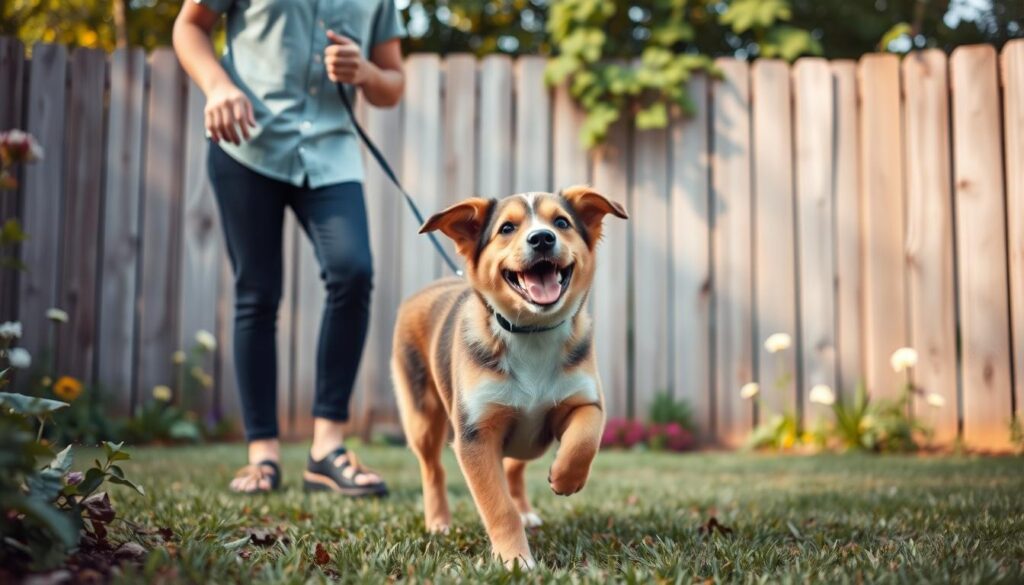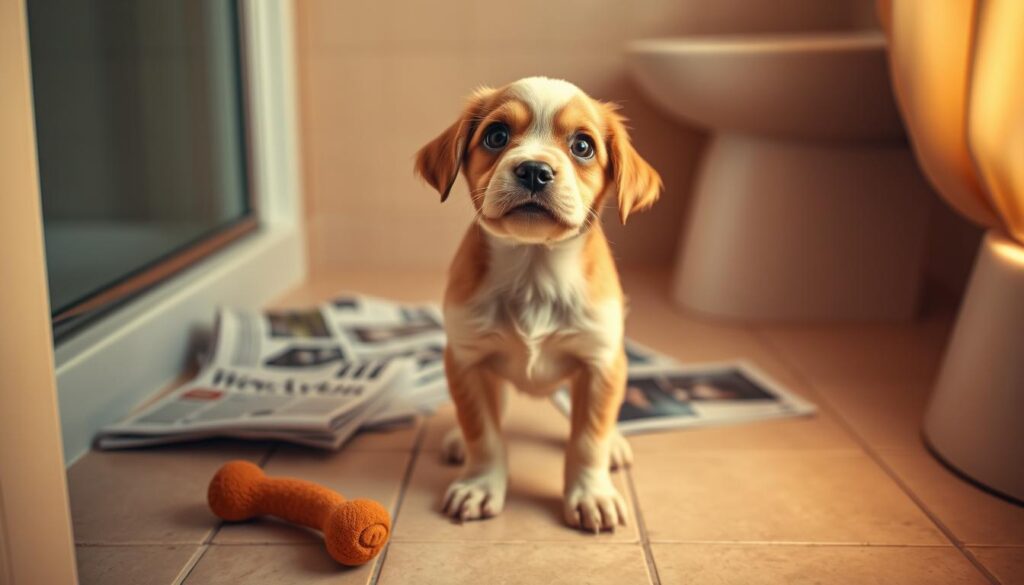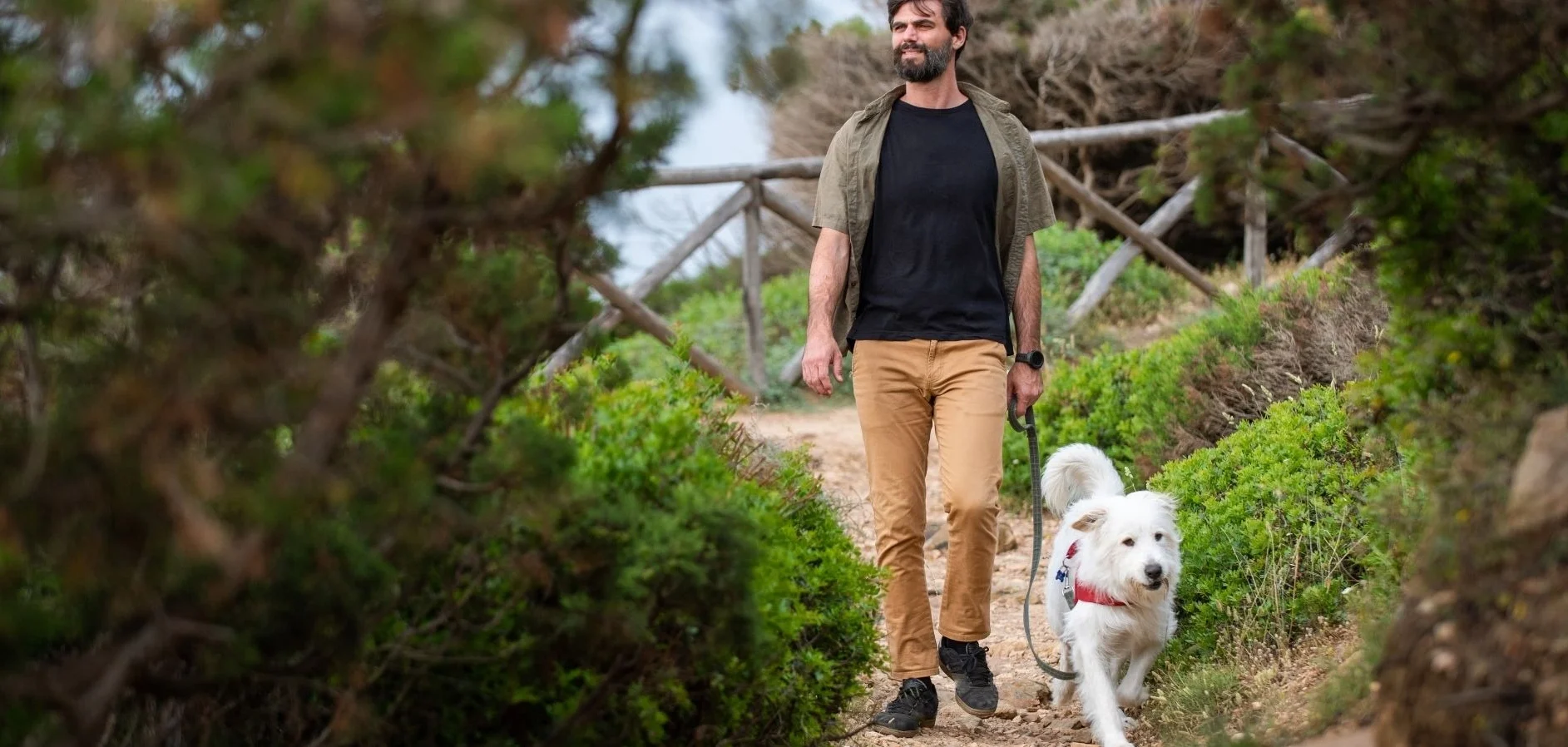Potty Train Dog: 5 Happy & Easy Steps for Success
Table of Contents
Potty Train Dog
Every dog owner faces the challenge of indoor accidents. I remember the first time I brought home a puppy. It was overwhelming to start dog toilet training.
Potty training is more than just keeping your floors clean. It’s about connecting with your dog and creating a peaceful home. This guide will change how you approach house training, making it easier for you and your dog.
If you’re new to dog ownership or need to retrain an adult dog, we’ve got you covered. Our detailed plan will give you the tools and confidence to succeed. You can effectively train your dog, and we’ll show you how.
Key Takeaways
- Potty training is crucial for a happy home and strong dog-owner relationship
- Consistent training prevents behavioral issues and shelter surrenders
- Every dog can learn with patience and proper techniques
- Early training prevents long-term house soiling problems
- Positive reinforcement is the most effective training method
Understanding the Importance of Potty Training
Housebreaking a puppy is more than just keeping your floors clean. It’s a key process that builds trust and structure. It also improves communication between you and your dog. Good housetraining tips can make your home a happier place.
Benefits for You and Your Dog
Successful potty training brings big benefits for both you and your dog. By following consistent housetraining tips, you’ll see:
- Improved hygiene in your living space
- Reduced cleaning and maintenance
- Enhanced understanding between you and your puppy
- Prevention of potential behavioral issues
Building a Stronger Bond
The journey of housebreaking a puppy is all about communication. Every successful potty training session strengthens your bond. Positive reinforcement and patience teach your dog important skills. They also help build respect between you and your dog.
Reducing Stress at Home
A well-trained dog means less stress for everyone. Mastering housetraining tips creates a routine that makes your puppy feel safe. This routine cuts down on accidents and cleaning stress. It makes your home a peaceful place.
“Training your dog is an investment in your shared future together.” – Professional Dog Trainer
Choosing the Right Time to Start
Starting potty training at the right time is key. Your dog’s age, needs, and traits are important for a good potty training plan. Knowing when to start is crucial for success.
Dogs at different life stages need different potty training methods. Picking the right start time can greatly improve your training.
Age Considerations for Puppies
Puppies can’t hold their bladder well and need extra care during potty training. Here are some tips for young dogs:
- Puppies can hold their bladder for one hour per month of age
- Start crate training around 8-16 weeks old
- Expect frequent bathroom breaks every 1-2 hours
Timing for Adult Dogs
Adult dogs might need different potty training strategies than puppies. Consider their past experiences and current living situation.
- Rescue dogs may require more patience
- Establish a consistent potty training schedule
- Use positive reinforcement techniques
Your Dog’s Individual Needs
Every dog is different. Your potty training plan should fit your dog’s:
- Breed characteristics
- Previous training history
- Physical health conditions
- Living environment
Pro tip: Watch for your dog’s specific signals and adjust your crate training and potty training schedule accordingly.
Essential Supplies for Successful Training
Getting ready for indoor potty training means collecting the right tools. The success of your dog’s training depends on the right equipment. This makes the process easier for you and your dog.
Potty Pads and Their Alternatives
Choosing the right accessories makes indoor potty training simpler. Here are some must-haves:
- Absorbent potty pads with leak-proof backing
- Washable indoor grass patches
- Disposable training mats
- Pee pads with attractant spray
Crates and Their Benefits
Crate training is a great way to potty train your dog. The right crate offers a safe space and controls your dog’s area during training. Pick a crate where your dog can stand, turn, and lie down comfortably.
Pro tip: Choose a crate with adjustable dividers for growing puppies. This makes crate training more affordable.
Cleaning Supplies for Accidents
Accidents happen during potty training. Keep these cleaning supplies on hand:
- Enzymatic cleaners that eliminate odors
- Paper towels
- Disposable gloves
- Stain removers specifically designed for pet accidents
Remember, patience and consistency are key in successful indoor potty training.
Establishing a Routine
Creating a good potty training schedule is key for your dog’s bathroom habits. A regular routine helps your dog know when and where to go. This reduces accidents and boosts their confidence.

To make a bathroom routine work, focus on a few important steps. Your potty training schedule should be clear and predictable. This gives your dog clear bathroom times.
Setting Up a Consistent Schedule
A reliable potty training schedule is the base of successful house training. Here are some key timing tips:
- Take your puppy outside every 2 hours during the day
- Schedule potty breaks immediately after waking up
- Go outside 15-30 minutes after meals
- Take your dog out before bedtime and first thing in the morning
Recognizing Signs Your Dog Needs to Go
Knowing your dog’s body language can stop accidents. Look out for these signs:
| Behavior | Potential Bathroom Need |
|---|---|
| Circling | Immediate urge to eliminate |
| Whining | Signaling discomfort or need to go outside |
| Sniffing the floor | Searching for a spot to relieve themselves |
| Sudden restlessness | Potential bathroom emergency |
Creating a Designated Potty Area
Choose a specific outdoor spot for bathroom breaks. Consistency is key in a bathroom routine. Always take your dog to the same spot. This helps them know where to go.
Remember, patience and positive reinforcement are crucial. Every dog learns at their own pace. Stay consistent and celebrate small wins.
How to Train Your Dog in Steps
Potty training your dog needs patience, consistency, and a smart plan. The right tips can make this tough task easy and fun. Success comes from using positive training methods.
Good dog training starts with a clear plan. Breaking it down into simple steps keeps you and your dog on track.
Initial Introduction to the Potty Area
Finding the right potty spot is key. Pick a place that’s easy to get to and has no distractions. Show your dog this spot often, like after eating, sleeping, or playing.
- Select a specific outdoor spot or indoor area
- Maintain a consistent location
- Minimize distractions during training
Using Positive Reinforcement Training
Positive reinforcement is the heart of good dog training. Reward your dog with treats, praise, or their favorite toy when they use the potty area right. This teaches them good behavior is rewarded.
| Training Technique | Reward Type | Timing |
|---|---|---|
| Successful Potty Use | High-Value Treat | Immediate Praise |
| Consistent Location Use | Favorite Toy | Within 3 Seconds |
Gradually Increasing Independence
As your dog gets better, give them more time between potty breaks. Look for signs they need to go, like sniffing or whining. Patience is key in this step.
- Start with frequent potty breaks
- Observe your dog’s signals
- Gradually increase time between breaks
- Maintain consistent praise and rewards
Common Potty Training Challenges
Potty training a dog isn’t always easy. Even the most dedicated pet owners face obstacles. Knowing these challenges helps you stay patient and confident during training.

Dealing with Accidents
Accidents are a normal part of potty training. It’s important to stay calm and understand these moments. Never punish your puppy for accidents. This can make them scared and slow down training.
- Clean accidents thoroughly with an enzymatic cleaner
- Remove odors that might encourage repeat incidents
- Avoid harsh reactions that could traumatize your puppy
“Patience is the most important tool in housebreak puppy training.” – Professional Dog Trainer
Regression in Training
At times, a dog might forget what they learned. This can happen for many reasons, like stress or changes in routine. It’s also possible due to health issues.
- Identify potential triggers for regression
- Return to basic training techniques
- Maintain a consistent schedule
Fear or Anxiety Issues
Some dogs get anxious about potty training. Emotional support and gentle guidance are key in these situations.
Here are some tips for training a dog with anxiety:
- Create a calm, safe potty environment
- Use positive reinforcement
- Consult a professional if anxiety persists
Every dog is different, and potty training needs a tailored approach. Be consistent, and you’ll see your puppy make progress.
Tips for Specific Breeds
Dog toilet training isn’t a one-size-fits-all approach. Different breeds have unique characteristics that impact housetraining tips and strategies. Understanding these breed-specific nuances can help you create a more effective potty training plan for your furry friend.
Every dog breed brings its own set of challenges and considerations to dog toilet training. Breed size, temperament, and physical characteristics play crucial roles in determining the most successful housetraining approach.
Small Breeds and Their Unique Needs
Small dog breeds often require more frequent potty breaks due to their tiny bladders. Housetraining tips for smaller dogs include:
- Scheduling more frequent bathroom trips
- Using smaller potty pads or indoor grass patches
- Being patient with slower learning curves
- Considering indoor toilet solutions for apartment living
Large Breeds and Space Considerations
Larger dogs need different dog toilet training strategies. Their physical size and metabolism impact potty training techniques:
- Requiring larger designated outdoor areas
- Managing longer intervals between bathroom breaks
- Using consistent verbal commands
- Creating spacious training environments
Mixed Breeds: A Unique Training Approach
Mixed breed dogs might inherit traits from multiple breed backgrounds, making housetraining tips more complex. Observe your dog’s individual characteristics and adapt your training method accordingly.
Professional dog trainers recommend customizing your approach based on your specific dog’s needs and learning style.
Remember that patience, consistency, and positive reinforcement are key to successful dog toilet training, regardless of breed.
Techniques for Unusual Situations
Potty training isn’t always easy. Some dog owners face special challenges. This guide will help you potty train your dog, no matter the situation.
Training an Older Dog
Older dogs can learn new habits. They need patience and consistent training. Start by understanding their routine and any patterns.
- Make a predictable bathroom schedule
- Use positive reinforcement
- Deal with any past issues
- Keep training sessions short and frequent
Addressing Health Concerns
Health issues can affect potty training. Some conditions cause frequent urination. Talk to your vet for a special training plan.
| Health Condition | Potty Training Approach |
|---|---|
| Urinary Tract Infection | More frequent bathroom breaks |
| Mobility Issues | Accessible indoor potty areas |
| Digestive Problems | Adjusted diet and monitoring |
Potty Training in Apartments
Urban dog owners have special challenges. Indoor potty training is key in apartments. Here are some tips for apartment owners:
- Choose high-quality indoor potty pads
- Make a special potty area
- Use scent markers to guide your dog
- Keep a regular routine
Tip: If you work long hours, consider hiring a dog walker or using pet-sitting services to maintain your dog’s potty training schedule.
Every dog is different. Tailor your training to fit your situation. Stay patient during the process.
When to Seek Professional Help
Dog toilet training can be tough, making many pet owners feel stuck. Most can housebreak a puppy on their own. But, some cases need a pro to get it right.
Signs You May Need a Trainer
Knowing when to get help is key for your dog’s success. Look out for these signs that you might need a pro:
- Persistent accidents despite consistent training efforts
- Aggressive behavior during toilet training
- Regression in previously learned housebreaking skills
- Excessive marking inside the home
- Anxiety or fear associated with designated potty areas
Choosing the Right Professional
Finding the right dog trainer is important. Look for someone with experience in puppy training and positive methods.
- Check professional certifications
- Read client testimonials
- Request a consultation
- Verify specialized training in dog toilet training
- Ensure alignment with your training philosophy
Understanding Professional Methods
Trainers use special techniques for dog toilet training challenges. They create plans based on your dog’s breed, age, and behavior.
Professional help can turn a tough housebreaking situation into success.
A good trainer will work with you. They’ll use consistent, effective methods to help your dog learn and grow.
Celebrating Milestones with Your Dog
Potty training is a journey filled with small victories. These victories are worth celebrating. Your dog’s progress shows more than just bathroom habits—it’s about building trust.
Each successful bathroom routine is a chance to celebrate and strengthen your bond. The key to effective training is to acknowledge even the smallest achievements. When your dog uses the potty area correctly, give them praise and a treat right away.
This method reinforces good behavior and makes training fun. Your excitement will encourage your dog to keep up the good work.
Recognizing Achievements
Keep a simple training log to track your dog’s milestones. Note the days when accidents decrease and successful potty uses increase. Seeing progress can be very motivating for both you and your dog.
Rewarding Progress
Choose rewards that your dog loves. Some dogs love treats, while others prefer praise or playtime. The goal is to make potty training a fun, rewarding experience that brings you closer.
Keeping a Positive Atmosphere
Stay patient and enthusiastic during training. Your dog picks up on your emotions, so be calm and supportive. Every dog learns at their own pace. Consistent, loving guidance is the best way to help them.
FAQ
How long does potty training typically take?
Potty training time varies by dog’s age, breed, and learning pace. Puppies usually take 4-6 months. Adult dogs might need a few weeks to a few months. Being consistent, patient, and positive is key.
What are the most effective potty training methods?
Top methods include crate training, a consistent routine, positive reinforcement, and monitoring. A regular schedule for feeding, breaks, and rewards is crucial. This helps your dog learn to go in the right place.
How often should I take my puppy out to potty?
Puppies need to go out every 1-2 hours during the day. They also need to go after waking up, eating, drinking, or playing. A 3-month-old puppy should go out about every 3 hours.
What should I do if my dog has frequent accidents?
If accidents happen often, check your training. Make sure you’re taking your dog out enough and watching for signs. Clean up accidents with an enzymatic cleaner. Don’t punish your dog. Instead, use positive reinforcement and consider a professional trainer if needed.
Can older dogs be potty trained?
Yes, older dogs can learn to use the potty. It might take more time and patience. Start with a strict schedule, positive reinforcement, and be ready to spend more time training.
How do I choose the right crate for potty training?
Choose a crate that fits your dog comfortably. It should be big enough for them to stand, turn, and lie down. For growing puppies, a crate with a divider is best.
What are the signs that my dog needs to go potty?
Look for signs like sniffing, circling, whining, or scratching at the door. These are early warnings to prevent accidents and guide your dog to the potty area.
How do I handle potty training in an apartment?
Use indoor potty pads or a designated area in an apartment. Stick to a routine, take walks, and use positive reinforcement. Some people use balcony potty solutions or portable grass patches.
What cleaning supplies are best for potty training accidents?
Use an enzymatic cleaner for pet accidents. These cleaners remove urine and feces odors. Avoid ammonia-based cleaners, as they can attract your dog to the same spot again.
When should I seek professional help for potty training?
Get professional help if accidents keep happening, your dog is anxious or fearful, or if you’ve tried many methods without success. A trainer can offer strategies tailored to your dog’s needs.
There are no reviews yet. Be the first one to write one.


